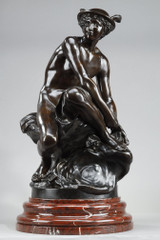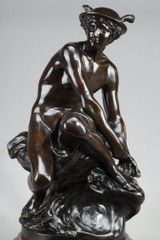A bronze sculpture with a brown patina depicting Mercury (Hermes), god of commerce, thieves, and messenger of the gods, seated on a rock fastening his winged stoup. He wears a petasos, a winged hat, and his caduceus rests on the ground. This sculpture, after a model by Jean-Baptiste Pigalle, shows a young, nude god in motion. In a double-pivoting pose, he is preparing to leap. The bronze, resting on a stepped circular base of griotte red marble, is signed on the base "Pigalle, 1745". The original of this sculpture was the reception piece for Pigalle's Royal Academy of Painting and Sculpture on July 30, 1744, which entered the Louvre between 1848 and 1850. Circa: 1850
Jean-Baptiste Pigalle:
The Sculptor of the Enlightenment. A great French sculptor, Jean-Baptiste Pigalle was born in Paris in 1714. He honed his craft from a very young age under the tutelage of Robert Le Lorrain and later Jean-Baptiste Lemoyne. Convinced that his art was his life's purpose, he traveled to Italy in 1734 to refine his technique. Upon his return, he began his "Mercury Fastening His Heel" (1740), which earned him admission to the École des Beaux-Arts. His reputation grew among the Parisian aristocracy. Madame de Pompadour took him under her wing, and commissions poured in. Skillfully blending Baroque and Classical styles, he created portraits of Diderot and Voltaire, and later produced the famous funerary monuments for Marshal de Saxe (Strasbourg, completed in 1776). He died in Paris in 1785, leaving behind a remarkable body of work.
Condition report: The bronze is in perfect condition. Height of the marble base: 10 cm. Chips on the edge of the marble base.
Delivery
Europe: €500
US/Canada/HK: €400
Rest of the world: Price upon request
- Reference :
- 3326
- Width :
- 38 (cm)
- Height :
- 70 (cm)
- Depth :
- 38 (cm)
- Era:
- 19th century
- Materials:
- Bronze























































